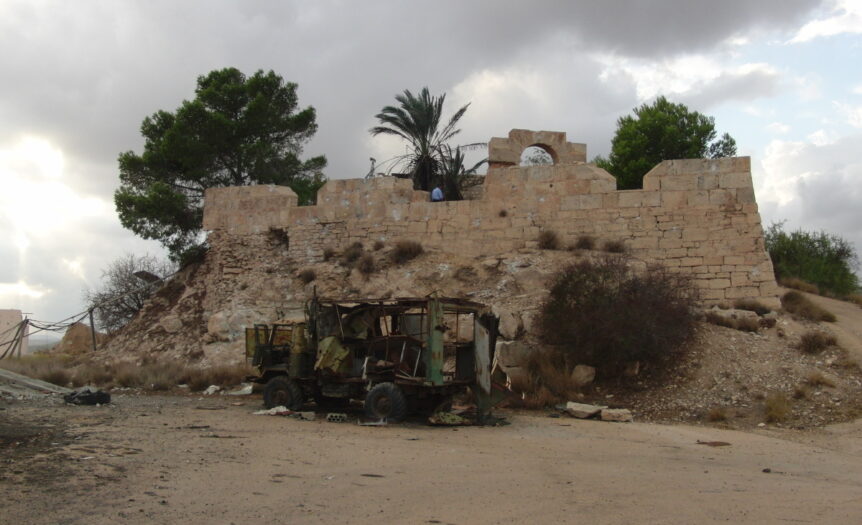Dialogue with Peter G. Stone, president of the international organization The Blue Shield, which since 1996 has defended cultural heritage in the event of conflict, natural disasters or man-made disasters
Professor Peter G. Stone is the president of the international organisation The Blue Shield, and UNESCO chair in Cultural Property Protection and Peace at Newcastle University. He also was advisor to the UK’s Ministry of Defense regarding the identification and protection of the archaeological cultural heritage in Iraq and has remained active in working with the military to refine attitudes and develop processes for the better protection of cultural property in times of conflict. For his career and merits in the field of heritage education, in 2011 Stone was made an Officer of the Order of the British Empire (Civil).
 The Blue Shield works for the protection of cultural heritage during armed conflicts or following natural and man-made disasters. What is the key principle of its work, and what its purpose?
The Blue Shield works for the protection of cultural heritage during armed conflicts or following natural and man-made disasters. What is the key principle of its work, and what its purpose?
“Where they burn books, they will also ultimately burn people”, wrote the German poet Heinrich Heine. Likewise in China, back in the 6th century BC, the destruction of the enemy of cultural heritage was deplored to avoid new conflicts that would be driven by revenge. This consciousness, which finds evidence in various occasions throughout history, gave rise to the international conventions that followed the world conflicts of the last century. The well-being of a community is indeed connected with those tangible and intangible cultural properties that give people a sense of identity and belonging, a sense of place and dignity that enhance the coherence of the community itself. Eradicating the memory of a place, the traces of a historical monument, or intangible traditions means reflexively undermining the identity of that people. It has been evident in many conflicts, including recent ones: when specific ethnic groups or populations are affected, so is the cultural heritage with which they identify themselves. In the former Yugoslavia, landscapes of death were the same for people and monuments: mass graves were found to be filled not with earth, but with the rubble of their worship place – a mosque in this case – so that it would not be possible to keep any trace, neither of one nor the other. I don’t think there could be a more tragic yet evident image to prove the connection between a community and its cultural heritage.
The mission of The Blue Shield can be summarized as protective strategies that consider people inseparable from the cultural heritage, within the impossibility of protecting one where the others were destroyed. Working both at a national and international level, it aims to spread this unitarian vision to heritage protection and to promote an environment of peace through education, science, and culture.
The protection of cultural heritage can be the sole responsibility of protection bodies or an opportunity to promote dialogue and cooperation. Between these two extreme positions, how did the creation of The Blue Shield come about?
The Blue Shield was envisaged, but not created, by those who joined together at the 1954 Conference to establish the Hague Convention on the protection of cultural property in the event of armed conflict. Those who gathered there had just lived through at least one, and many of them two world wars. That international community created UNESCO to guarantee an environment of peace through education, science, and culture. In 1948 the Universal Declaration of Human Rights acknowledged integrated access to culture and cultural sites as part of human rights and in the same year, the Genocide Convention identified cultural genocide, to combat the destruction of people’s cultural property. The Blue Shield was finally created in 1996 and today it is an internationally recognized organization for the protection of cultural heritage in case of armed conflicts or following natural and man-made disasters.
The cultural patrimony holds a high level of complexity, collecting right inside a plurality of heterogeneous elements. Which strategies are thus involved?
The vast group categorized as cultural heritage includes small objects in a museum, libraries, archives, single monuments, or even entire historical centers. Moreover, there is the intangible patrimony, made of local traditions, terms, patterns, and colors that are meaningful only to the people who know and experience them. The context in which they are placed is unique, as is each conflict and the dynamics that led to it. It’s thus inevitable for each case to require a specific intervention strategy and measured actions. For instance, you may need boxes to protect art pieces but you could also work on a dedicated program to move them to a safer place. Cultural heritage is as varied as the techniques to protect it. At their basis, however, it is possible to outline a common and preventive strategy: the commitment to the dissemination of a critical education that precedes any dramatic event and is capable of recognizing the role of cultural heritage before it is damaged or, in the worst case, destroyed.
How does The Blue Shield work and how does it structure its mission?
The international conventions and laws for the protection of cultural heritage arise from the belief that – having acknowledged the inevitability of conflicts and disasters – it may be possible to draw constraints that avoid irreparable actions towards a greater dialogue, preparatory to reconciliation.
The Blue Shield is part of this process by working both with the Nations that recognize international protocols and with those that do not and by raising awareness of the strategic role that the protection of cultural heritage can assume. So doing it aims to strengthen the synergies with the humanitarian sectors and with the uniform ones, considering not only military but also peacekeepers such as blue helmets, border police, etc. … Of course, for the missions carried out in the urgency of conflicts to be effective, it is necessary to work in peacetime: a key aspect is to organize workshops and training programs to increase Nations’ interest. Even in cases of military occupation, the protection of the local cultural heritage could prevent military escalations, internal revolutions, or even civil wars. Likewise, an ongoing partnership between the different protection bodies can improve the response to a catastrophic event, as seen in the explosions in the port of Beirut, Lebanon, in 2020.
Your words bring up an evident topicality relating to the European scenario, the conflict in Ukraine and the symbolic role of religious cultural heritages…
One of the things that The Blue Shield is keen on doing is working more closely with religious communities and organizations, at least the major ones. The religious building, as the current situation in Ukraine also proves, is often a focal point for the local communities who can find in it not only a physical shelter but also that sense of spiritual and moral safety. It is therefore difficult to treat these properties as if they were, for example, a museum collection that can be transported to a safer place and protected there. In these cases, the movable patrimony of churches must be safeguarded locally, avoiding their displacement, because the population constantly refers to them. There is a dialogue that needs to be developed between The Blue Shield and the religious world to work out together the most effective way to protect those buildings and their contents.
Narrating conflicts through the processes of safeguarding or, unfortunately, destruction of cultural patrimony may generate unexpected stories and a new understanding of the conflicts themselves. Stories that should be written or anyway communicated…
I agree, however, communicating the activities of The Blue Shield is not easy because many of them are subject to confidentiality clauses and can only be announced long after they were developed. However, with its 13 national committees, our organization is surely expanding… Furthermore, if we consider the most recent conflicts, specific attention to cultural heritage allows us to make comparisons and develop strategies to avoid new disasters. Ensuring cultural heritage means ensuring the stability of populations: a growing number of studies show how human communities living around historical, religious, and identity heritage achieve a higher quality of life than those who live without such references.
Concluding, mutual respect between people cannot be ignored when aiming at a stable and sustainable condition of peace. This respect is proved also with the protection of the relative heritage, which therefore plays a fundamental role in pursuing a global environment of peace.

























